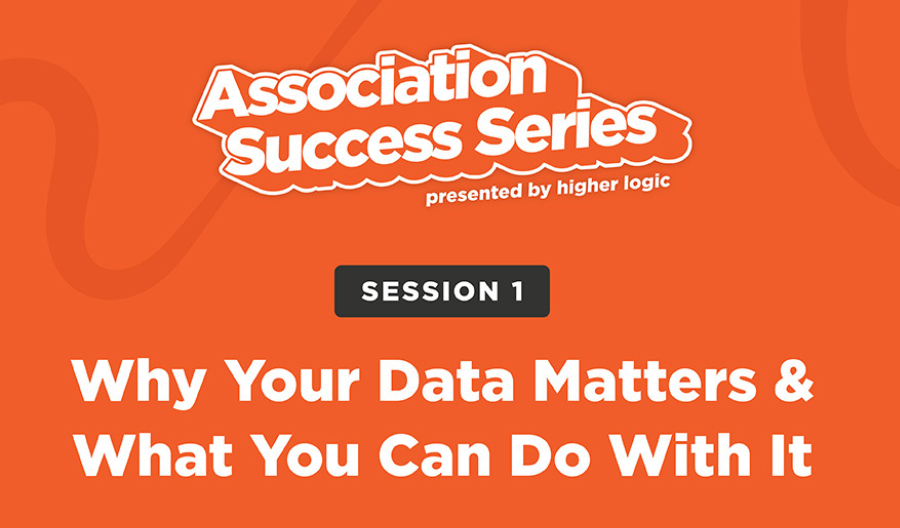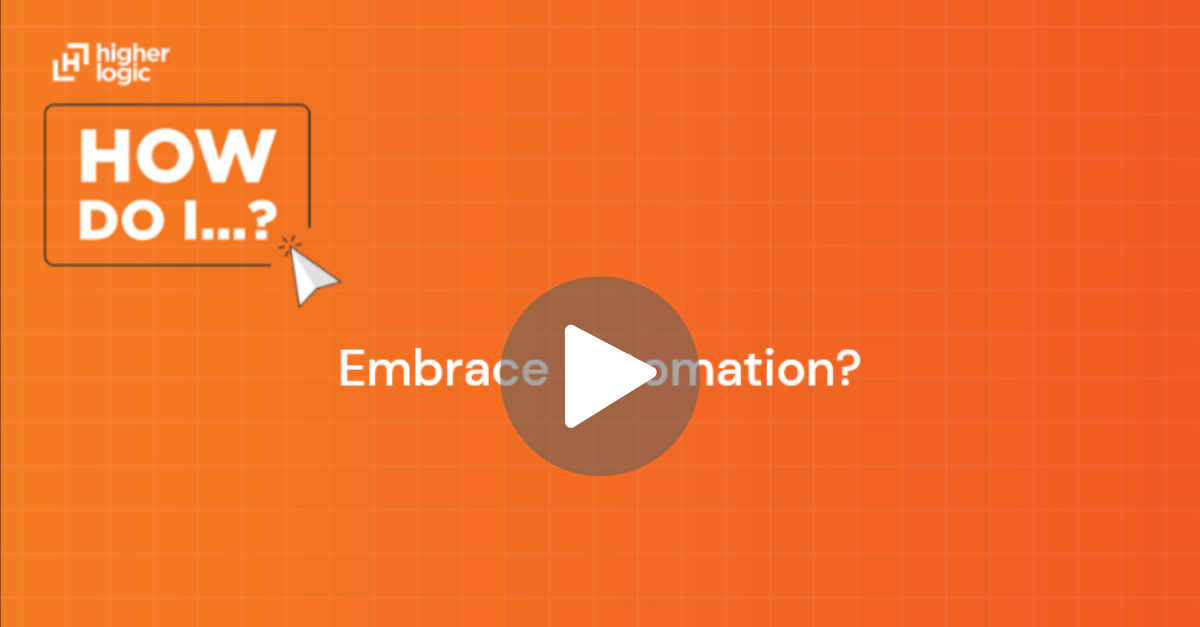Email Marketing Automation: Save Time, Increase Engagement

You probably already know that email marketing is one of the most effective channels for communicating with your members. The question is, how are you amplifying the impact of your messages? At this point, most organizations know what marketing automation is. Yet it’s surprising how many aren’t really using it, or aren’t realizing it’s potential to supercharge communication and engagement.
You might be ready for email marketing automation if:
- You struggle to personalize experiences.
- Members are seeking more value.
- Email engagement declines.
- Your team is stressed and stretched thin.
- Your email marketing relies too heavily on one person.
- Team turnover disrupts the continuity of evergreen marketing automation campaigns.
Sometimes the word “automation,” in marketing automation buries the real value. Yes, email marketing automation saves you time by automating some of your work. However, a key strength of marketing automation is its ability to help you segment, target, and customize your messages.
So let’s dive into the differences between standard email marketing and automated email marketing. We’ll also cover some marketing automation strategies.
Why Add Automated Email Marketing to Your Strategy?
You hear people complain about inbox overload all the time – you’ve probably complained about that yourself. People still rely on email as a primary source of information, but so do companies. Higher Logic’s 2024 Association Member Experience Report showed that members still choose email as their #1 communication method. Yet, it also showed that the number of members saying they get “too many emails” increased from 34% in 2023 to 50% in 2024.
How do you make sure your organization’s emails aren’t the ones people delete? As you might expect, it’s all about delivering personalized value. People don’t mind getting emails that align with what they want or need.
That’s why sending every email to everyone is so damaging. Sending your emails to more people may seem good, but if many of them are not interested, you waste your time and theirs.
Automated email marketing helps you ensure that the messages you send to your members are timely and relevant.

Email Marketing vs. Email Marketing Automation
Regular email marketing involves manually creating and sending emails to a list of subscribers, often for promotions, newsletters, or announcements. It requires hands-on effort each time an email campaign is sent and is typically one-size-fits-all, meaning every recipient gets the same message. In contrast, automated email marketing uses predefined triggers and workflows to send personalized emails based on user behavior, preferences, or actions. This approach ensures timely, relevant communication—such as welcome emails, abandoned cart reminders, or re-engagement campaigns—without constant manual intervention. As a result, automation saves time, increases efficiency, and improves engagement by delivering the right message to the right person at the right time.
Marketing automation also minimizes the risk of disjointed messaging coming from different team members and departments. It it can help you manage email flow, timing, and recipient selection to avoid over-messaging, repeat-messaging, and lack of focus.
What is Email Marketing Automation in Practice?
So marketing automation is using software and technology to automate repetitive marketing tasks and workflows. In practice, this means you can automate anything from planned email campaign sends, to member segmentation, to behavior-triggered messages. What you automate is up to you
Trying to segment and personalize your email marketing manually can be tedious and time-consuming, which limits your ability to communicate with each of your members effectively. With marketing automation, you can deliver personalized content to different segments – and even individual members – at scale.
Marketing automation platforms offer various features that help businesses streamline and personalize their email marketing efforts. Some of the most common tools include:
1. Dynamic Content
- Allows emails to display different text, images, or offers based on the recipient’s preferences, behaviors, or demographics.
- Example: You could show non-members and members a different callout message at the bottom of your emails—all within the same email.
2. Drip Campaigns
- A series of automated emails sent over time based on user actions or time delays.
- Example: A new subscriber gets a welcome email immediately, followed by an introduction to services after three days, and a special offer after a week.
3. Behavioral Triggers
- Emails sent in response to specific user actions, such as signing up, making a purchase, or abandoning a cart.
- Example: If a user downloads a free eBook, they receive a follow-up email suggesting related content.
4. Segmentation
- Dividing email lists based on criteria like demographics, purchase history, or engagement levels.
- Example: Your organization can send different emails to beginners and advanced professionals, offering tailored education suggestions.
5. A/B Testing (Split Testing)
- Sends different versions of an email to a small portion of the audience to see which performs better before sending the best version to the full list.
- Example: Testing two subject lines to see which gets more opens before rolling it out to the entire audience.
6. Lead Scoring or Engagement Scoring
- Assigns a score to contacts based on their interactions, helping organizations identify people who show high interest or intent to engage with certain things.
- Example: You might flag certain actions, like visiting your certification page or clicking on certification reminders in your newsletter as indicators that someone is interested in your certification program, and trigger automatic follow-up with more information.
7. Personalization & AI Recommendations
- Uses customer data to personalize subject lines, product recommendations, and content.
- Example: You suggests programs or member resources based on previous registrations or web-tracking.
8. Web Tracking
- Adds code to your website and then a cookie is placed on a user’s browser when they click through on one of your emails, making them a “known user.” As long as that cookie remains, it tracks that user’s activity on your website and writes that information back to you.
- Example: If you see known non-member contacts that regularly visit your membership page, you could automate follow-up providing the with more information and asking if they have any questions.
Popular marketing automation platforms like Higher Logic Thrive, HubSpot, and Mailchimp offer these types of features to help organizations scale their email marketing efforts efficiently.
Examples of Email Marketing Automation Campaigns
Sometimes it’s easier to picture the impact of email marketing automation with examples. Some helpful automated email campaigns include:
- Welcome/Onboarding Campaign: Effective member onboarding is the first step to ensuring member engagement, and ultimately membership renewal. It’s also an ideal campaign to automate. Depending on how you store member join information, you can use marketing automation to set up an automated welcome email to go out within 24 hours of capturing a new membership or email subscription. Your campaign might then include a series of follow-up emails, (which you can use dynamic content to personalize based on stated interests) to shine light on proven value drivers like access to an exclusive online community, educational resources, industry events, mentoring opportunities, and more.
- Membership Renewal Campaign: Chances are, your organization has a standardized series of membership renewal reminders (if you don’t, you should). By automating this campaign, you open up opportunities to personalize renewal messaging based on member data, like level of engagement or interest areas. You can highlight the things that matter most to different member segments, reminding them of the value they gain by being part of your organization. You also don’t have to spend so much staff time following up with people manually, which opens up your time for targeted follow-up with people who you think are at risk of lapsing. The American Society of Consultant Pharmacists (ASCP) saw great success and time saved from their automated membership renewal campaign!
- Winback/Lapsed Member Campaign: And if someone does lapse, you can automate your lapsed member winback campaign too. Deploying a targeted lapsed member campaign allows you to rekindle connections and address the concerns or barriers that led to the lapse. The American Association for Respiratory Care (AARC) used Higher Logic to create a personalized win-back campaign that brought back 800 lapsed members!
- Event/Program Promotion Campaign: If your current process for event or program promotion involves a scramble to send out one-off emails at random intervals when you think of it, you’re certainly not along. An email marketing automation strategy can make event promotion much more cohesive, efficient, and effective. You can set up a series of messages that tell one complete story about your event and pre-schedule them to go out periodically leading up to your event. You can automatically filter out registrants and even funnel them into their own registrant campaign. You can create ideal member segments by pulling lists of recipients with related interests. For a conference with multiple tracks, you could even use dynamic content to highlight different tracks for different people in the same message. All this helps you score more registrations and better member satisfaction.
- Member Engagement Campaign: Activities such as form submissions, web page visits, course completion, or clicking on specific email links provide you with information that can trigger automated relevant follow-up communication. You can responding both to what members DO and what they DON’T do. Inactivity can be a powerful trigger for outreach. For example, members that haven’t opened an email in a defined time frame (3+ months) could be sent an automated campaign with specific calls to action to re-engage the member. A continued non-response would trigger additional follow-up communications with a strong and compelling reason to re-engage. As part of any re-engagement campaign, you want to explore all viable channel options for reaching members, especially if one channel is suddenly not producing results
- Prospecting Campaign: Are you aware of certain activities that indicate someone might be interested in membership? For example, if someone attends several events open to non-members, visits your associations job board, or frequents an open online community you host. Or let’s say someone visits your membership benefits page multiple times without signing up. All these could be set up to trigger follow-up about membership. Marketing automation allows you to act on indicators of interest to reach out to prospective members at JUST the right time.
Want to learn how to create automated email marketing campaigns?
Automating your email marketing saves time and improves personalization. But it takes planning to prepare an impactful marketing automation campaign. So we created step-by-step “recipes” to help you get started.
Developing Your Email Marketing Automation Strategy
As you embark on your journey or email marketing automation, it helps to have a plan. Developing an email marketing automation strategy is crucial for understanding what automated email campaigns will have the most impact, and ensuring your campaigns achieve achieving your outcomes.
A well-defined strategy also helps you think of ways to personalizing the member experience and send the right messages reach the right audience at the right time. So what are some ways to develop your email marketing automation strategy?
- Start by defining your goals and identifying your target audience segments. Conduct thorough research to understand your members’ preferences, behaviors, and pain points. Some organizations find it helpful to create marketing personas to organize this data. Understanding your member segments will help you choose the best segments for particular messages, and tailor your messaging accordingly.
- Ask yourself what member data you have that you could act on to trigger campaigns.
- Create a content calendar that outlines the types of email campaigns you will send, including welcome series, renewal reminders, and targeted campaigns based on member interests.
- For each campaign you’d like to run, whether it’s an ongoing campaign or a specific promotional series, map out how you’d like it to flow. What messages do you want to include? How do you want to time the messages?
- Implement dynamic content to personalize emails for different segments, ensuring relevance and engagement.
- Data fuels marketing automation. Connecting or integrating your systems (like your AMS, marketing automation software, online community, and more) helps you leverage member data from across your technology infrastructure to better personalize your member experience.
- Utilize data analytics to track engagement metrics for the campaigns you’re running and refine them accordingly. Continuously test and optimize your campaigns by analyzing performance data, allowing you to adapt your strategy and improve results over time.
Want to Take a Deeper Dive?
Check out our Ultimate Guide to Marketing Automation to learn more about creating an effective marketing automation strategy.
Monitoring and Optimizing Automated Email Marketing Performance
To maximize the effectiveness of your automated email marketing efforts, it’s essential to monitor key metrics. Luckily, the main metrics are already familiar to you from your standard email marketing.
Organizations should track key metrics such as open rates, click-through rates (CTR), conversion rates, bounce rates, and unsubscribe rates.
- Open rates indicate how compelling subject lines are.
- Click-through rates measures how engaging the email content is.
- Conversion rates reveal how effectively emails drive desired actions, such as purchases or sign-ups.
- Bounce rates help identify deliverability issues, and unsubscribe rates highlight potential problems with content relevance or frequency.
To maximize effectiveness, you can also A/B test subject lines, email copy, and call-to-action (CTA) buttons, optimize send times based on audience behavior, and use segmentation and personalization to deliver more targeted messages.
Regularly analyzing data and refining automation workflows based on insights will ensure continuous improvement and better ROI from email marketing automation efforts.

Selecting the Right Email Automation Tools
The marketing automation platform you use can also impact how successful your email marketing automation is. Choosing the right email automation tools is crucial for success. When you’re shopping around, consider factors such as ease of use, features, integrations, pricing, and customer support. Get recommendations from peer organizations. It’s also fair to ask the vendor to provide the names of some existing customers you can talk to. No tool is perfect, but you want the one that delivers effective email automation for the best value.
Tips for ChoosingEmail and Marketing Automation is Transformative
Sometimes “Automation” gets a bad rap. It gets misconstrued as being impersonal. But as you can see, the advantages outlined above prove just the opposite.
Marketing teams have only so much time and staff to achieve the high level of personalization members are looking for today. It’s literally impossible to know every individual member’s needs, behavior, status, and preferences (all of which are constantly changing) and manually create and maintain custom segments and copy for everyone. Marketing automation makes that possible. And you’re still in control, deciding what data to use to define member segments, and what behaviors should trigger follow up.
With marketing automation, and a deep understanding of your members, you can take every opportunity to nurture each individual with valuable, engaging emails, and do that at scale.
Related Resources
Learn more about email marketing automation.
Association Success Series: Why Your Data Matters & What You Can Do With It
During this webinar, data experts Christin Berry from ASAE, and David Jovel from Higher Logic share how associations can harness...
Read MoreHow do I… embrace automation?
Adopting automation can save hours of staff time – but it can sound like a big lift if you don’t...
Read MoreUltimate Guide to Marketing Automation
Marketing automation enables you to set up responsive, data-driven email workflows and deliver personalized content to members. Learn how!
Read More





